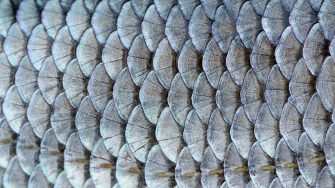Harnessing nature’s design: using fish scales to improve lightweight armour
UNSW Canberra researchers are using the unique shapes of fish scales to unveil a novel frontier in protective armour
UNSW Canberra researchers are using the unique shapes of fish scales to unveil a novel frontier in protective armour

In the world of engineering, inspiration often emerges from the most unexpected sources. Fish scales – seemingly simple and unassuming – are the focus of a recently published paper by UNSW Canberra researchers, inspiring the way forward for innovative lightweight and resilient armour.
Research from UNSW Canberra has shown that fish scale-inspired armour holds significant promise due to its unique blend of lightweight, flexible and protective capabilities.
Uses could include protective gear like armour vests and helmets, automotive components, lightweight aerospace and aviation parts, impact-resistant cladding for the construction industry, and biomedical devices.
“The versatility of fish scale-inspired protective materials makes them a promising area of research and development, with potential benefits across a wide range of industries and everyday applications,” said UNSW Canberra PhD candidate, Hari Dura.
Why would researchers turn to fish scales for inspiration?
According to Hari, the answer lies in the fish scale’s structural efficiency, hydrodynamic features, and diverse applications across engineering and design.
Fish scales, known for their strength, hardness and flexibility, have long served as nature’s armour. Some fish species, such as the arapaima and coelacanth, rely on scaled armour for defence.
Over millions of years of evolution, fish scales have continuously adapted and improved. Their overlapping and flexible arrangement not only shields the fish but also offers a valuable template for engineers and designers seeking to create robust yet lightweight structures.
“Fish scales provide formidable protection by laying over the soft tissue and internal organs, all while enabling fish to move with agility and grace,” Hari said.
“It's this combination of strength, flexibility, and adaptability that makes fish scales exceptional protective structures, ensuring the survival of these aquatic creatures."
In their paper published in Composite Part A: Applied Science and Manufacturing, UNSW Canberra researchers were able to tune the mechanical performance of fish scales by changing the curve of the scale.
The findings demonstrated that fish scale-inspired designs with smaller radii (i.e. more curved) exhibit superior energy absorption and maximum force resistance. According to Hari, the enhanced stiffness of curved scales derives from their ability to provide localised resistance.
“The flexural stiffness of the bio-inspired design could be improved by 9% compared to the straight plate scales, illustrating that fish scale morphology can be mimicked to design better protective structures,” Hari said.
“To our understanding, this is the first time that anybody has studied the effect of curved scales. This study helped us better understand the defence mechanisms in bio-inspired body armour – especially in fish scales.”
As researchers continue to explore the practical application of nature's designs, fish scale-inspired armour is just one example of the remarkable ingenuity that can be found in the natural world. This research shows where lightweight, resilient, and sustainable protective gear is heading.